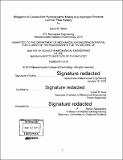Mitigation of losses from hydrodynamic mixing in a hydrogen bromine Laminar flow battery
Author(s)
Gilson, Laura (Laura Marie)
DownloadFull printable version (5.939Mb)
Other Contributors
Massachusetts Institute of Technology. Department of Mechanical Engineering.
Advisor
Cullen R. Buie.
Terms of use
Metadata
Show full item recordAbstract
The hydrogen bromine laminar flow battery is a promising technology for grid-scale energy storage. It dispenses with the expensive membrane used in traditional flow batteries, instead using laminar flow to maintain the separation of fluid streams. It also takes advantage of powerful, inexpensive chemical reactants. However, mixing between the fluid streams within the battery reduces its single-pass performance and cyclability. Conditions at the inlet junction where oxidant and electrolyte streams come together are thought to influence mixing. This work investigates the relationship between fluid flow at the inlet junction, mixing, and battery performance. Matching electrolyte- and oxidant-stream flow rates or velocities is predicted to cause less mixing than employing hydrodynamic focusing of the oxidant stream. When hydrodynamic focusing is used in channels with heights on the order 500 [mu]m or less, numerical simulations show recirculating flows at the inlet junction and experimental results show a decrease in limiting current. However, for matching inlet velocities or flow rates experimental results show limiting current consistent with predictions that assume no mixing. This result shows a path forward achieving higher power density in the hydrogen bromine laminar flow battery by prioritizing symmetry of the inlet flow conditions as the channel height is decreased.
Description
Thesis: S.M., Massachusetts Institute of Technology, Department of Mechanical Engineering, 2016. Cataloged from PDF version of thesis. Includes bibliographical references (pages 63-64).
Date issued
2016Department
Massachusetts Institute of Technology. Department of Mechanical EngineeringPublisher
Massachusetts Institute of Technology
Keywords
Mechanical Engineering.